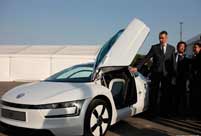Annual Report on Actions to Address Climate Change (2013) was released on Monday in Beijing. The report focuses on low-carbon urbanization this year.
The report presents systematic analysis of the context, meaning, policies, strategic goals and pathways of urbanization, suggestion that low-carbon development is the core constraining factor for the new type of urbanization. The critical point of urbanization is not speed but how to avoid high carbon lock-in. Adaptability management and carbon budge management shall be better integrated in to urban development in order to construct low- carbon and resilient cities, synergistically addressing climate change and contribute to the realization of Beautiful China.
"In the next three decades, China is not only going to continue the process of urbanization, but also improve its quality. It has become imperative to increase the adaptability and resilience of Chinese cities," said Wang Weiguang, the dean of Chinese Academy of Social Science, who is also known the chief editor of the green book.
Wang delivered a speech at the green book launch and said that in the past few decades, China’s urbanization is in a typical extensive outreach and unsustainable mode, featuring high energy consumption, high emission, high expansion and high cost in terms of environmental resources.
Low-carbon urbanization is a critical component of new urbanization concept and an effective way to improve urbanization quality as well as greenhouse gas emission control. Meanwhile, it is becoming more and more apparent that extreme climate disaster makes cities vulnerable.
From early January 2013 to mid-October, China reported 29.9 hazy days, 10.3 days more than the same period of the past year, setting a new record since 1961, Zheng Guoguang, Director of China’s Meteorological Administration cited the latest data during his speech.
He said in past several months rainstorm occurred mainly in the northeast, northwest areas and Sichuan Basin in China. And southern provinces had experienced severe drought and hot weather. "Extreme weather events remind us that the process of urbanization do have an impact on climate change. Similarly, the climate change does impact on urbanization. It is an interaction."
Since the Doha Conference in 2013, Chinese government has been promoting the ecological civilization construction as well as the green and low- carbon development, implementing strong domestic policies and actions addressing climate change, pushing forward the international negotiation process constructively according to the principles of equity, respective capacities and common but differentiate responsibilities, thus making positive contribution in global governance on climate change.
By the end of 2012, China has selected a series of pilot projects for low-carbon development across the country, including 6 provincial level pilots, 36 low- carbon pilot cities, 26 low- carbon transportation cities, 7 green and low-carbon towns. Developing low-carbon cities has become a main focus in reducing energy consumption, transforming precious development patterns and seeking emerging urban competiveness around the world.
Experts on climate science, energy, climate policies and urbanization who wrote about hot topics such as low-carbon transition practices and climate resilience of cities for the green book are invited to give presentation on the publish meeting on Nov. 4 as well. They present insightful analysis on low- carbon development and climate risk management through a collection of case studies, including studies on rainstorm that hit Beijing in July 21, 2012, low-carbon and hurricane Sandy that hit New York.
 Fire guts 22-storey Nigeria commercial building in Lagos
Fire guts 22-storey Nigeria commercial building in Lagos U.S. Navy Carrier Strike Group stages military exercises
U.S. Navy Carrier Strike Group stages military exercises Volkswagen showcases new energy vehicles in Beijing
Volkswagen showcases new energy vehicles in Beijing  How should we get married nowadays?
How should we get married nowadays?  Commentary:
Commentary: Jakie Chan sees Rubber Duck off in Beijing
Jakie Chan sees Rubber Duck off in Beijing Hello! Horror Halloween Celebration!
Hello! Horror Halloween Celebration!  The catwalk to the world of fashion
The catwalk to the world of fashion  Cruise trip to Taiwan
Cruise trip to Taiwan  Unveil PLA air force base
Unveil PLA air force base  Say goodbye to tube-like apartment building
Say goodbye to tube-like apartment building Oriental education or western education?
Oriental education or western education? China in autumn: Kingdom of red and golden
China in autumn: Kingdom of red and golden National Geographic Traveler Photo Contest
National Geographic Traveler Photo Contest Chinese screen goddesses from Beijing Film Academy
Chinese screen goddesses from Beijing Film Academy Day|Week|Month